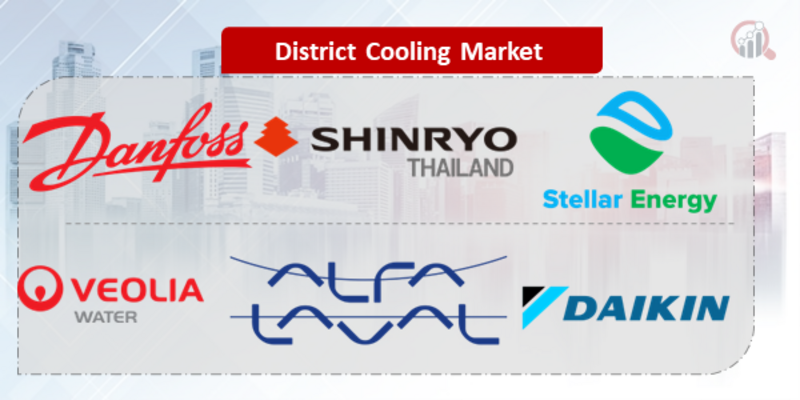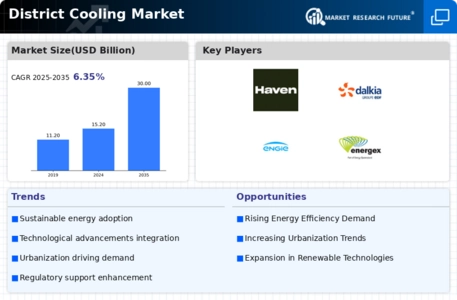Top Industry Leaders in the District Cooling Market

District Cooling Market: A Comprehensive Analysis of Key Players, Strategies, and Emerging Trends
The district cooling market is currently undergoing a substantial growth spurt, driven by factors such as increasing urbanization, a heightened focus on energy efficiency, and growing concerns about climate change. These influences have attracted a diverse array of participants, resulting in a dynamic and fiercely competitive landscape. This article delves deep into the competitive scenario, outlines key player strategies, and explores emerging trends in this thriving market.
Key Players and Their Strategies:
- Veolia (France)
- Danfoss (Denmark)
- Emirates District Cooling, LLC (EMICOOL) (UAE)
- Shinryo Corporation (Japan)
- Alfa Laval AB (Sweden)
- ADC Energy Systems LLC (UAE)
- Daikin Industries Ltd. (Japan)
- National Central Cooling Company PJSC (TABREED) (UAE)
- SNC-Lavalin (Canada)
- Keppel Corporation Limited (Singapore)
- Emirates Central Cooling System Corporation (EMPOWER) (UAE)
- Qatar District Cooling Company (QATAR COOL)
- Stellar Energy (USA)
- Engie (France)
Veolia (France): Veolia stands out as a formidable player, leveraging its expertise in water management and energy optimization to provide comprehensive district cooling solutions. The company places a strong emphasis on technological innovation, consistently investing in research and development to advance thermal storage and energy efficiency technologies.
Danfoss (Denmark): A key Danish player, Danfoss contributes significantly to the district cooling market. Known for its commitment to sustainability, the company focuses on developing and implementing advanced technologies such as smart control systems and renewable energy integration.
Emirates District Cooling, LLC (EMICOOL) (UAE): EMICOOL has carved a niche for itself in the district cooling market, particularly in the UAE. As a regional player, the company capitalizes on its local knowledge and existing infrastructure to develop smaller-scale district cooling networks, with a keen eye on densely populated areas.
Shinryo Corporation (Japan): Hailing from Japan, Shinryo Corporation is a noteworthy participant, contributing to the global district cooling landscape. The company's strategic approach involves a focus on technological innovation and efficient system optimization.
Alfa Laval AB (Sweden): Alfa Laval, based in Sweden, plays a crucial role in the district cooling market. With a diverse portfolio of successful projects across various regions, the company maintains a competitive edge, coupled with a commitment to technological innovation.
ADC Energy Systems LLC (UAE): A prominent UAE-based player, ADC Energy Systems LLC actively engages in the district cooling market. The company's involvement includes the development of smaller-scale district cooling networks in densely populated regions, leveraging local knowledge and existing infrastructure.
Daikin Industries Ltd. (Japan): Daikin Industries, originating from Japan, is a significant contributor to the global district cooling sector. The company's strategies revolve around technological innovation and a commitment to sustainability.
National Central Cooling Company PJSC (TABREED) (UAE): TABREED, based in the UAE, is a key player in the district cooling market. The company's strategic focus includes developing large-scale networks in collaboration with governments and private entities.
SNC-Lavalin (Canada): SNC-Lavalin, a Canadian entity, is actively involved in the district cooling landscape. The company's strategies encompass collaborations with city planning authorities, expanding its reach and facilitating project execution.
Keppel Corporation Limited (Singapore): Based in Singapore, Keppel Corporation Limited is a notable participant in the district cooling market. The company's strategies include forming strategic partnerships with governments, developers, and technology providers.
Emirates Central Cooling System Corporation (EMPOWER) (UAE): EMPOWER, based in the UAE, is a significant player in the district cooling sector. The company's strategies involve the development of large-scale networks, particularly in the Middle East.
Qatar District Cooling Company (QATAR COOL): QATAR COOL is a prominent player in the district cooling market, focusing on the development of large-scale networks in the Middle East.
Stellar Energy (USA): Stellar Energy, based in the USA, contributes to the global district cooling landscape. The company's strategies include a commitment to energy efficiency and sustainability.
Engie (France): Engie, a global leader in energy services, has extensive experience in district cooling projects worldwide. The company's strategy involves partnering with governments and private entities to develop large-scale networks, particularly in the Middle East and Asia.
Cushman & Wakefield: Cushman & Wakefield, a consulting giant, plays a crucial role in market advisory and feasibility studies for district cooling projects. The company collaborates with developers and investors, bringing financial expertise and market insights to the table.
Emerson: Emerson, a leading technology provider, contributes to the district cooling market through equipment manufacturing and automation solutions. The company's focus on energy-efficient chillers, pumps, and control systems optimizes system performance and reduces operational costs.
Local Utilities and District Energy Companies: In addition to global players, numerous regional and local utilities and district energy companies actively participate in the market. They leverage local knowledge and existing infrastructure to develop smaller-scale district cooling networks, particularly in densely populated areas.
Factors for Market Share Analysis:
Project Portfolio and Geographical Reach: Companies with a diverse portfolio of successful projects across various regions gain a competitive edge. For instance, Engie's presence in over 20 countries and Veolia's operation in more than 40 cities globally provide them with a significant advantage.
Technological Innovation and Efficiency: Continuous development and implementation of advanced technologies like thermal storage, smart control systems, and renewable energy integration attract clients and demonstrate industry leadership.
Financial Capacity and Risk Management: The ability to secure funding for large-scale projects and manage financial risks effectively is crucial. Engie's partnership with investment banks and Veolia's strong balance sheet showcase financial stability.
Partnerships and Collaborations: Strategic partnerships with governments, developers, and technology providers expand reach and facilitate project execution. Cushman & Wakefield's collaborations with city planning authorities and Emerson's partnerships with equipment manufacturers highlight this strategy.
Emerging Trends and New Players:
Integration of Renewable Energy Sources: Companies are increasingly incorporating renewable energy sources like geothermal and solar power into their district cooling systems, promoting sustainability and reducing the carbon footprint. Veolia's project in Dubai utilizing solar-powered chillers is a prime example.
District Heating and Cooling Integration: Merging district cooling with district heating infrastructure is gaining traction, offering year-round energy optimization and resource utilization. Engie's project in Amsterdam combining both systems demonstrates this trend.
Data-Driven Operations and Smart Grid Integration: Implementing smart technologies and AI for real-time monitoring, demand forecasting, and system optimization is becoming crucial. Emerson's focus on smart control systems and data analytics aligns with this trend.
Rise of New Players: Start-ups and smaller companies are entering the market with innovative solutions, particularly in areas like modular district cooling systems and advanced control software. Companies like Deepcooltech in the UK and Ice Energy in the US are noteworthy examples.
Overall Competitive Scenario:
While large, global entities contribute significantly, the active participation of regional players adds a layer of diversity and adaptability to the competitive landscape. The future promises continued growth and evolution, driven by technological advancements and a collective commitment to sustainable and efficient cooling solutions.










